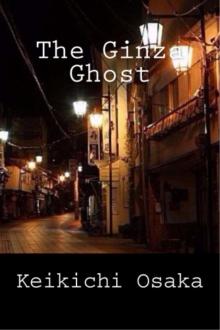- Home
- Keikichi Osaka
The Ginza Ghost Page 24
The Ginza Ghost Read online
Page 24
[ix] Higan week is the week of the spring equinox, in which many Buddhist memorial services are performed.
[x] The adzuki bean (occasionally spelled azuki or aduki) is an important element in Japanese cuisine, especially as an ingredient for red bean paste, which is often used as a filling for Japanese sweets.
[xi] Senbei (occasionally spelled sembei) are rice crackers made from glutinous rice. There are various shapes and flavours available.
[xii] One sen is 1/100 of one yen. It is no longer in use.
[xiii] Count Maresuke Nogi (1849-1912) was a general in the Imperial Japanese Army and a prominent figure in the Russo-Japanese War of 1904-05. He was seen as a national hero in Imperial Japan, dedicating his life to the emperor and the army. One episode has Nogi asking the emperor permission to commit suicide to atone for the soldiers he lost during his capture of Port Arthur. He was denied, but Nogi eventually did commit ritual suicide on the funeral day of the Meiji emperor.
[xiv] Edo is the old name of the city now known as Tōkyō. Shitamachi, or ‘downtown,’ is the old merchant heart of the city.
[xv] In Japan, water is scooped up from a well and splashed over the gravestone during a visit. The tradition originates from Buddhism, where one of the afterworlds, Gakikai, is said to be one of eternal thirst and hunger. The water splashed over the gravestone is to quench the thirst of the deceased in case they end up in Gakikai. The custom lives on even now, though in modern days it is usually done to clean the grave.
[xvi] Botan Dōrō, or The Peony Lantern, is a classic ghost tale about a man falling in love with a ghost. The man’s health becomes worse each time he has sexual relations with his ghostly lover.
[xvii] A fusuma is a sliding door consisting of a wooden frame and Japanese paper.
[xviii] Tatami are straw mats commonly used as flooring material.
[xix] A tokonoma is an alcove in a traditional Japanese room, where usually objects for artistic appreciation are displayed, like scrolls.
[xx] A tansu is a mobile Japanese chest of drawers very commonly used in pre-modern Japanese culture.
[xxi] Traditional Asian age-reckoning practices had the newly born start at the age of one, so at the next birthday they celebrated, they became two years old. The traditional age system was abolished by law in 1902 in Japan, but remained widely in use until after World War II.
[xxii] It was possible for local governments, private organisations and persons to hire police constables in Japan between 1881 and 1938. They were for example hired by mining companies to ensure safety among the miners or by the wealthy for protection.
[xxiii] In folklore, a shimenawa rope is used to seal off consecrated areas, and as a talisman to ward off evil.
[xxiv] An igeta, or “well curb” pattern is a common pattern used for kimonos. It resembles a cluster of number symbols (#).
[xxv] Oden is a popular traditional winter dish consisting of various ingredients like eggs, daikon and fishcakes stewed in a soy-flavoured dashi broth. It is a popular street stall food.

 The Ginza Ghost
The Ginza Ghost